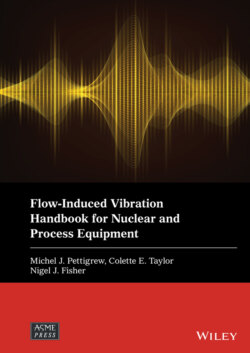Читать книгу Flow-Induced Vibration Handbook for Nuclear and Process Equipment - Группа авторов - Страница 44
2.4.5 Susceptibility to Resonance
ОглавлениеCoincidence of acoustic and shedding frequencies does not necessarily cause resonance. Resonance also depends on acoustic energy and acoustic damping. Several design criteria have been proposed to evaluate susceptibility to tube bundle resonance. The design guidelines of Blevins and Bressler (1987) and of Ziada et al (1989) are suggested for heat exchanger tube bundles.
Blevins and Bressler (1987) suggest that resonance is less likely for closely packed tube bundles, probably because acoustic damping is higher. Also, closely packed tube bundles probably prevent the formation of larger vortices that are associated with higher acoustic energy. From experimental data for first‐mode acoustic resonance, Blevins and Bressler (1987) show that resonance is unlikely for P/D < 1.6 and L/D < 3.0 for staggered (triangular) tube bundles, and for L/D < 1.4 for in‐line (square) tube bundles. Here, P is the transverse pitch and L is the longitudinal pitch. However, they do not discuss the applicability of their criterion to higher‐order acoustic modes.
Ziada et al (1989) propose a resonance parameter to assess susceptibility to resonance. For staggered arrays (triangular), this parameter has the form
(2‐43a)
where Rcr is the Reynolds number based on the critical flow velocity at resonance, and v is the kinematic viscosity for the shell-side gas. The resonance parameter, Gs, is correlated versus the flow path parameter, L/h, in Fig. 2-19b for both resonance and non‐resonance data. The parameter L/h is defined in Ziada et al (1989).
Fig. 2-19 Proposed Damping Criteria (Resonance Parameter) for: a) In‐Line (Square) Arrays; b) Staggered (Triangular) Arrays (Ziada et al, 1989 / with permission of Elsevier).
Similarly, for in‐line arrays (square)
(2‐43b)
The parameter Gi is plotted against (XL)2 in Fig. 2-19a, where XL = L/D. For a satisfactory design, it must be shown that the heat exchanger tube bundle is in the non‐resonance parts of Fig. 2-19.
